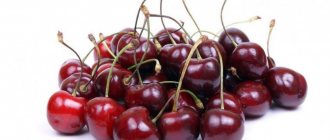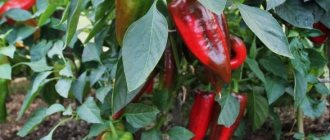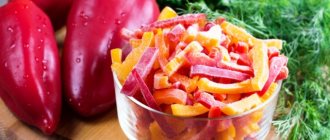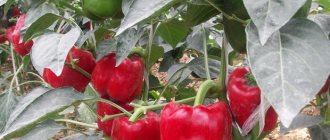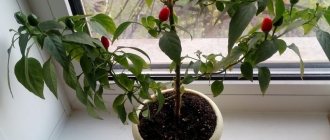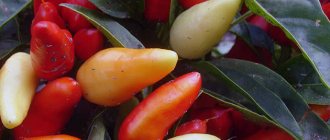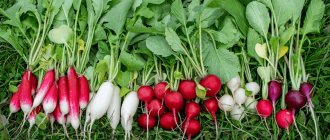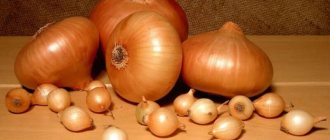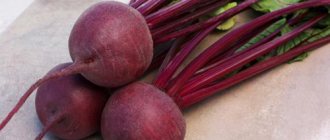Characteristics and description of the variety
- The Gladiator pepper is distinguished by its truncated pyramidal shape.
- The surface of the fruit has a slight gloss with mild ribbing.
- The fruits are bright yellow.
- The mass of pepper can reach 370 g. The walls of the vegetable can be 14 mm thick. The thick, dense pulp has a very delicate, sweet and peppery aroma.
- The main purpose of the variety. The fruits can be eaten fresh, boiled, fried, or canned.
- Dutch collectors created a mid-season variety. Technical maturity occurs 115 days after the appearance of sprouts.
The plant has spreading and vigorous branches. On average, a bush can have a height of no more than 50 cm.
This variety can be grown in a greenhouse, in an open bed, and also with film shelters.
Landing
The start date for sowing is mid-February. For seedlings, use soil for nightshades (purchased or independently compiled). The composition includes compost, humus, peat, the base is loose garden turf.
Before sowing, seeds are disinfected and soaked in an activator (aloe or Zircon).
The seedlings are kept warm (under a film until germination), then in a sunny southern window. Water with settled water, feed with diluted mullein, humate or Azotovit.
60-day-old seedlings are transplanted into permanent beds, maintaining a distance between holes of 50 cm. Scheme - 4 plants per 1 sq. m.
Features of growing and caring for the variety
First, seedlings are prepared. The seeds need to be sown to a depth of 3 cm. They begin to germinate at a temperature of about 27 C. When real leaves begin to appear on the plant, it must be transplanted into a separate cup. Its capacity should be 0.5 liters.
Since this pepper does not like being transplanted, after this procedure it takes a long time to come to its senses. A special drug can help restore his strength during this period. Timely watering, fertilizing and loosening of the soil are carried out.
This variety is mainly grown in regions with warm climates because the pepper loves a lot of sun.
Important! In order for buds to begin to form on the sprouts, you need to water them at the root with warm water so that the root system is not damaged!
Recommendations for cultivation
Attention! Seedlings of sweet peppers of the Gladiator variety begin to be prepared from mid-February to mid-March.
Seeds can simply be planted in prepared containers, but such planting will not ensure high germination rates. Experienced gardeners recommend preparing seeds in advance:
- All seeds are immersed in a container of water. Seeds that float to the surface are empty and unsuitable for planting.
- Soak the seeds in water for no more than 2 days. To increase the speed of their germination, you can add any growth stimulant to the water.
- Treating seeds with a weak solution of potassium permanganate. After this, they should be rinsed with warm water.
Such preparation of seeds will not only speed up the appearance of the first shoots, but also strengthen their immunity.
Important! Some producers do their own seed treatment. Information about this can be found on their packaging. Such seeds should simply be planted in the ground without additional procedures.
When planting, the seeds of the Gladiator variety are buried no more than 1.5 cm. Before the first shoots appear, they are covered with polyethylene or glass. For successful germination, they should be provided with a temperature of 23 to 28 degrees.
Young seedlings are planted permanently at the age of 60 days. Gladiator is a fairly heat-loving variety, so the place for planting it should be sunny and protected from the wind. Before planting this variety, it is recommended to add any organic fertilizer to the ground in the fall. If crop rotation is organized on the site, then it is better to plant pepper after the following crops:
- legumes;
- cucumbers;
- root vegetables and others.
Planting sweet peppers after green manure shows good results. In addition, they can be used to mulch the soil.
Regardless of whether Gladiator is planted in open or closed ground, there should be 35–40 cm of free space between neighboring plants.
Advice! The dimensions of the Gladiator bushes allow you to plant from 4 to 5 plants per square meter.
The Gladiator variety of sweet pepper is undemanding in terms of care, but for abundant fruiting it needs to be provided with:
- Lots of light and warmth. If the peppers are planted in open ground, then at first they can be covered with film at night. When planting in a greenhouse, you need to remember about regular ventilation. This is especially important during the formation of buds and fruits.
- Regular watering. As a rule, in our climate, the frequency of watering this crop will be at least 2 times a week. In this case, overhead watering can be done only until flowering. After the formation of buds, watering is carried out only at the root. For each Gladiator plant, the water norm is from 1 to 3 liters. It should only be warm. Watering with cold water will have a negative effect on the root system of plants.
- Regular loosening and weeding. Mulching the soil can replace these procedures. For Gladiator sweet peppers in the form of mulch, straw or green manure is perfect.
- Fertilizing with mineral and organic fertilizers. They should be carried out 2 weeks after planting, during the period when buds begin to form, and then during the period of active fruit growth. Excellent results are obtained by using bird droppings, slurry, and superphosphate.
With proper care, the Gladiator sweet pepper variety can bear fruit abundantly from mid-July to October.
We recommend that you familiarize yourself with the ten most common mistakes when growing sweet peppers:
Planting time for seedlings
You can start doing this in May. If the climatic conditions in your region are too harsh, you will have to use a covering material, a film. About six sprouts can fit on one square meter. Peppers are planted in the soil without making any special holes, since they do not have lateral roots.
Productivity. On one square meter you can get about six kilograms of crop.
Attention! When planting peppers in open ground, it is necessary to use film at night. If the plant is planted in a greenhouse, periodic ventilation should be done, especially when buds and fruits form!
Obtaining seedlings
Summer residents who want to get the maximum harvest of healthy Gladiator peppers must approach the growing process responsibly. Therefore, experienced agronomists advise sowing seeds and caring for seedlings yourself.
Gladiator pepper seeds can be collected independently from previously grown fruits or purchased in specialized stores. You should pay attention only to products from trusted manufacturers.
It is recommended to plant seeds after pre-treatment. They should be pickled in potassium permanganate for 20 minutes and washed with cold running water. After this, experienced gardeners in reviews advise soaking the seeds in a fertilizer solution, using “Zircon” and “Epina”. They can be alternated: first, the planting material is kept for 18 hours in one solution, then it is disinfected with potassium permanganate and soaked for another 18 hours in the second solution.
Mid-season varieties, which include Gladiator, should be sown 65 days before the planned date of planting in the ground.
Attention! The first ovaries should not be allowed to appear on seedlings that have not been transplanted into the ground. This exhausts the plants and delays the period of fruiting.
The seeds are buried into the soil no more than 1.5 cm. The container is covered with glass or polyethylene until the first shoots appear. The optimal temperature for seed germination is 23-27oC. If possible, it is better to plant the seeds in separate containers. Pepper does not tolerate picking well: even minor damage to the roots significantly lengthens the time of growing seedlings.
You can get strong seedlings if you organize a 12-hour daylight hours and carry out timely fertilizing. The first fertilizers are applied already in the phase of 1-2 leaves. Watering is important: at first, add water with a teaspoon to prevent the possibility of washing out the seedlings.
Advantages and disadvantages of the variety
- Does not succumb to various diseases.
- It has very large fruits.
- Easy to transport.
- Has high productivity.
- Has high commercial properties.
Among the disadvantages, it is worth noting the fact that pepper does not like windy weather and grows with difficulty in regions where clouds constantly cover the sun.
You may be interested in: Favorable days for picking pepper in 2021 according to the lunar calendar Favorable days for planting pepper for seedlings in 2021: terms and rules for sowing at home Favorable days for sowing sweet and bitter pepper for seedlings in 2021
How to grow Gladiator peppers correctly, recommendations and tips
It is necessary to first prepare special containers for subsequent seedlings. After this, you should plant the plant seeds in these containers. First you need to prepare the seeds for further planting. Professionals in this matter advise adhering to the following instructions:
- First of all, the seeds must be immersed in an aquatic environment. It is best to allocate a separate container for this, which will allow you to determine the quality of the seeds used for planting. Those that float are unusable and empty.
- Next, you need to soak the seeds in water for 2 days. In order to increase the rate of seed growth, you can add a growth stimulant to the water.
- Treat the selected seeds with a weak solution of potassium permanganate, then wash them in warm water.
Such manipulations will not only speed up the growth time of your seeds, but also increase their immunity to various pathogenic bacteria that often parasitize the leaves and fruits of vegetable crops.
When you begin to prepare the soil for planting seeds, you need to make a depression of no more than 1.5 cm, as this is enough for the successful development of your pepper. Regarding the temperature regime, it is extremely important to maintain a range from 23 to 28 degrees Celsius, since this is the interval that is most favorable for the successful growth of Gladiator.
Prepared seedlings should be planted in a permanent place at the age of 2 months. It is necessary to carefully select a site for planting. This place should be sunny, warm and isolated from strong winds, since this culture is quite thermophilic. In advance (preferably in the autumn), organic fertilizers should be added to the soil, which will enrich the soil with additional minerals and subsequently increase productivity.
The distance between plants should be slightly less than half a meter, since the pepper should not be in close quarters. As mentioned earlier, this variety is spreading. This fact must be kept in mind regardless of whether you plant the plant indoors or outdoors.
Resistance to diseases and adverse conditions
To grow this crop, you can make a temporary shelter. The plant cannot be affected by vertilosis.
By maintaining the necessary cleanliness of the planting and using pollination, the appearance of aphids and slugs can be prevented.
Remember! There will be no need to constantly weed the soil if it is mulched with siderites or straw!
Reviews of Gladiator pepper
Reviews about Gladiator pepper are very varied. Many people write that they have been planting this vegetable crop for quite a long time and are absolutely satisfied with the results. Others did not like the Gladiator pepper, and these gardeners switched to other crops that suited them better. Many gardeners in their reviews say that all their neighbors praise the beautiful rich yellow color of their peppers, constantly asking about what fertilizers they use and how often they care for the plant.
Read also: Large tomatoes: the best varieties for open ground
As a rule, negative reviews are left by those who did not carefully carry out all the procedures necessary for the high yield of this crop, or who encountered the cultivation of Gladiator pepper for the first time and did not fully understand the entire pattern of its growth.
Preparing for winter
You should not leave fruits on the bushes during frosts. You need to collect them in advance and place them in special boxes, boxes or other containers. It is better to stack them in sorted form.
Storage rules
To maintain the value of a product, it must be stored correctly. Pepper can be stored perfectly in boxes or paper bags. Having laid out the sorted fruits in containers, you need to leave them in a dark, cool place such as a basement or cellar.
Pepper "Gladiator": a worthy option for the new season
Everyone has sweet peppers on their table. This crop is useful, it can be grown throughout the country, there are many varieties - everyone can choose the best one for themselves. In order not to make many mistakes during cultivation, while gaining experience, you need to know more theory in advance. When you understand what seeds to buy and how to cultivate this vegetable later, the risks are minimal. Today we will present you with an excellent option for your garden - Gladiator pepper. The description of the variety and characteristics will show the pros and cons, the section on cultivation will show the cultivation technology. The reviews and photos of summer residents are pleasantly surprising.
Reviews from those who planted
“I have been planting this pepper for several years now. I liked the abundant fruiting and the size of the fruits. Even my neighbor liked the shade of this vegetable. It grows well inside my greenhouse and other varieties get along well with it. The main thing is to water it, sometimes feed it with organic fertilizer, and you can expect a good harvest.”
“I choose varieties according to their descriptions. In fact, you can grow good fruit. They are very tasty. The thick and dense pulp has a lot of juice and sweetness. I needed peppers for planting under film. This variety was just right.”
“I’ve only been gardening for a few years, but I’ve already been able to achieve success. They were especially evident in Gladiator. I didn’t even think that I would be able to get such a good harvest. Indeed, the pepper has grown so large and juicy. The bright yellow fruits glowed like lanterns on their bushes.”
The choice of many landowners fell on the Gladiator pepper variety because of the excellent quality of its fruits. They have a good presentation and can be used not only for home use, but also for sale. It's worth growing this vegetable! This is a very profitable idea!
Reviews
Those gardeners who have already grown this variety speak positively about it:
- Irina Pavlovna, who lives in the Moscow region, liked the Gladiator pepper because it does not cross-pollinate with other varieties planted in her greenhouse. Every year it produces good harvests.
- For its high yield, Pyotr Gennadievich from Voronezh, who grows it in the OG, chooses this pepper for himself.
- Alexey from Kazan notes the quality of the fruit. His peppers always turn out juicy, large and meaty.
As can be seen from the reviews of gardeners, Gladiator fully corresponds to the description. It confirms its best characteristics in practice. This pepper is really tasty, meaty and productive.
Pepper Gladiator
Yellow varieties of sweet bell peppers differ from red varieties not only in their color. The main difference between them is the concentration of nutrients. Yellow peppers have more vitamin C and pectin, while red peppers have more beta carotene. That is why yellow varieties of sweet peppers are a godsend for people who adhere to a healthy diet, as well as for people who are allergic to red vegetables. One of the most popular varieties of yellow pepper is the Gladiator variety.
Read also: Tomato General f1: description of the variety and secrets of cultivation
Agrotechnics of cultivation
We sow seedlings
The variety of sweet pepper “Gladiator” begins to be sown from February to mid-March. If the climate in the region is mild or you have a greenhouse and lamps, then you can sow early. If not, then it is better to postpone the moment until spring. But it is still better to purchase additional lighting, since even in March and April there are often many cloudy days. Pepper needs at least 10-12 hours of light.
Sowing is carried out after pre-treatment and selection of seeds. First, you need to discard empty seeds by soaking them in salt water - 1 spoon of salt per 1 liter of water. Then soak in potassium permanganate for 30-40 minutes, if there was no information about processing on the packaging. Next, the seed must be washed with warm water and dried on a radiator. The soil is prepared using soil from the garden, humus, sand and mineral fertilizer. The first two components are taken equally, sand is half as much, feeding according to the instructions. The soil is poured with boiling water and dried.
Peppers are usually planted directly into cups that can be transferred to the ground. This helps not to injure the very delicate root system. The seeds are buried 1 cm, moistened, and covered with film. The temperature for germination should be 26-29 degrees. When the seedlings have sprouted, the film needs to be removed, trays placed on the window and lighting nearby. Watering is carried out as it dries; feeding with “Kornevin” or “Epin” can be done at about the age of 10-14 days.
Transfer to the street
In May, when all the frosts have passed, the seedlings are planted in a permanent place. The area is dug up, humus or compost is added, and plant debris is removed. You will also need to pour boiling water over the area under the seedlings to protect them from insects and diseases. Mineral fertilizer rich in nitrogen and phosphorus is poured into the hole, watered with warm water and seedlings are planted. Before this, it is hardened for two weeks. No more than 4 plants are placed per square meter.
Care after landing
Caring for the Gladiator pepper variety is quite simple. Yield crops always require a lot of moisture and fertilizing. To maintain optimal moisture, bushes can be mulched with straw or sawdust. For the first week after planting, it is better to cover the seedlings at night; they do not need fertilizer. Mineral fertilizer is applied for the first time after two weeks; pepper needs a lot of phosphorus and potassium at this moment. Further feeding is applied every 14-20 days, alternating organic and mineral preparations. If you use droppings as fertilizer, then it is combined with watering. Additionally, you can use yeast supplements; this folk recipe is very effective (a bag of bulk product per bucket of water).
To further protect the bushes, they are sprayed with a manganese solution once a week, and ash is scattered throughout the garden. Of course, there should be no weeds on the site. If insects begin to bother you, they are driven away with folk infusions - tansy, wormwood, marigold, calendula, onion skins or garlic. To make it less difficult for the bushes, you can place supports in the form of sticks nearby.
Agricultural technology for pepper is simple. Yes, growing takes time, but the result exceeds all expectations.
